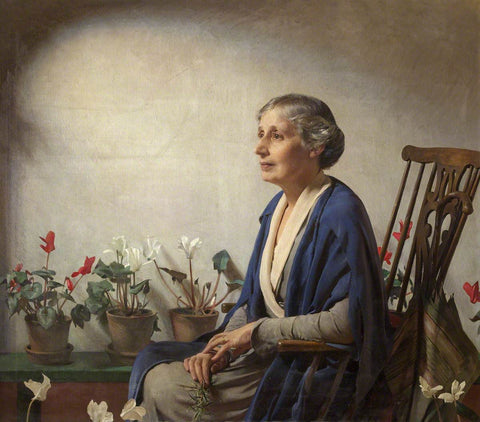Artwork of the Month: November

November's Artwork of the Month has been chosen by Leslie Glenn Damhus RWA. She has picked Waiting by Frederick George Swaish from the RWA Permanent Collection. Leslie writes:
'Looking to select a painting for the Artist of the Month from the RWA’s Collection, two portraits resonated with me immediately, and coincidentally they were both painted by the same artist. Frederick George Swaish’s (1879-1931) haunting portrait Waiting (also known as Portrait of the Artist’s Wife) seems to me to be full of symbolism and hidden meanings. My own work is inspired by Renaissance ideas of Italy and Northern Europe circa 1500, so I can’t help but look at this painting through these eyes.
The first thing I noticed was the luminous winter light. The subject is seated in a wooden chair - possibly a rocking chair - leaning slightly forward. She is bathed in a halo of radiant light from the window, leaving soft shadows on the top edges of the pale wall behind her, and the potted plants nearby. The red and white cyclamen help to clarify the time of year with their winter blooms.
I noticed her hands, beautifully painted and carefully posed, her wedding ring visible on her left hand and the other resting upon her lap. Between two of her fingers she holds a sprig of rosemary. Rosemary traditionally symbolises remembrance, love and fidelity. As Shakespeare’s Ophelia tells us: “There’s rosemary, that’s for remembrance. Pray you, love, remember.”
Rosemary also has a connection to religious stories of the Virgin Mary. It is believed that during the Virgin’s escape from Egypt, tired from the long journey she stopped to rest near a fragrant bush, which she draped her blue cloak on. The bush had white flowers and during the night they turned from white to blue. Thereafter, the bush was known as the ‘Rose of Mary’. In Swaish’s painting, the sitter is also draped in a blue cloak and not unlike the Renaissance depictions of the Virgin, her face also wears a peaceful expression of acceptance. Leaning discreetly on the chair, almost unnoticed against the wooden back, is an umbrella, a protection from the rain.
Swaish died in 1931, aged 52. There is no date on the painting but we can guess by the style of the sitter’s clothes that it was probably one of his later portraits, if not his last. If we are to believe that the sitter is Swaish’s own wife, could it be that he had foreseen his own passing? Is this painting intended for his wife to remember their life together, or is it simply about our longing for winter’s end?'
Frederick Swaish's painting will be on display on our upstairs landing throughout November.